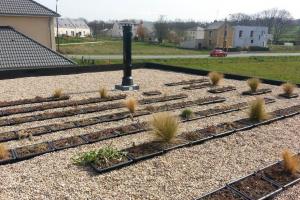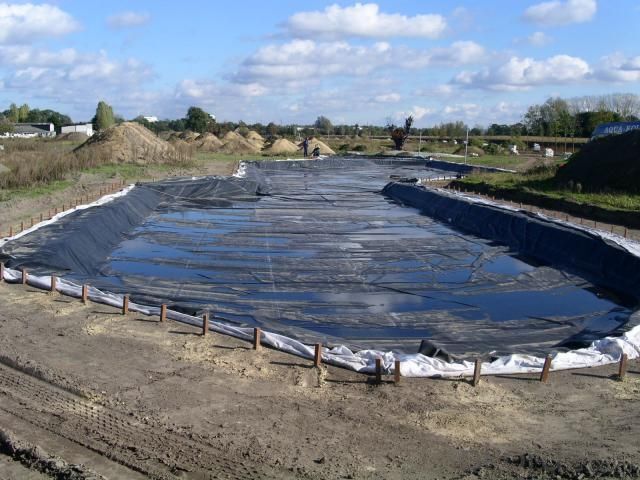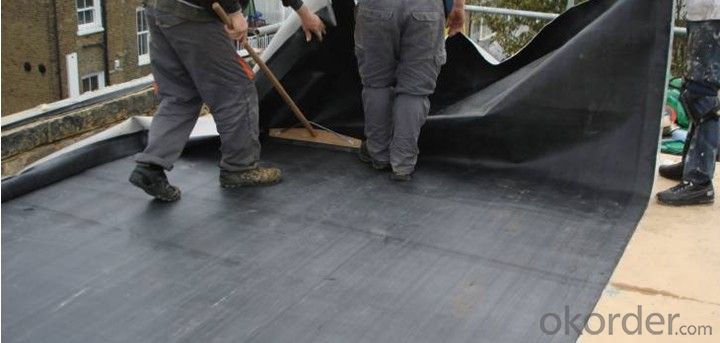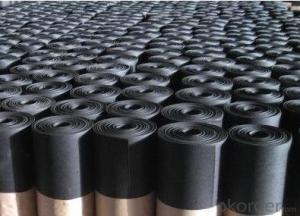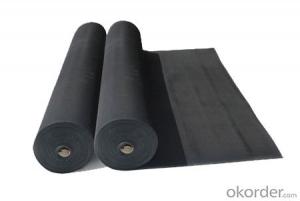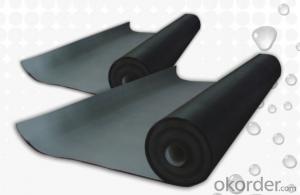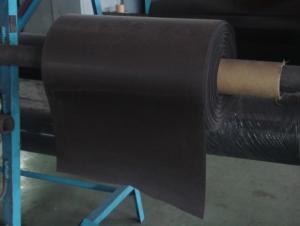EPDM Coiled Rubber Waterproof Membrane for Fields
- Loading Port:
- Shanghai
- Payment Terms:
- TT OR LC
- Min Order Qty:
- 50000 m²
- Supply Capability:
- 5000000 m²/month
OKorder Service Pledge
OKorder Financial Service
You Might Also Like
EPDM Coiled Rubber Waterproof Membrane for Fields
Description Of EPDM Coiled Rubber Waterproof Membrane for Fields:
•EPDM waterproof sheet has excellent anti-ozone-aging performance, able to resist ultraviolet light and corrosion of many chemical corrosive materials in the atmosphere
•It has high tensile strength, high ductility and strong retractility, it has excellent crack resistance, able to effect waterproof function even with tiny vibration of buildings.
• Excellent resistance to ozone, oxidation and sunlight.
• Resistance to chemicals; resistant to most inorganic products.
Main Features of EPDM Coiled Rubber Waterproof Membrane for Fields:
A.Polyester based SBS Modified Bitumen Waterproofing Membrane
a. Strong impermeability
b. High tensile strength, elongation, ability to adapt the grassroots shrinkage deformation and cracking
c. Puncture-resistant, broken resistant, tear-resistant
d. The corrosion resistance, resistance to mildew, weathering good
e. Construction convenient, hot-melt can be operated Four Seasons Construction, reliable joints
Specifications of EPDM Coiled Rubber Waterproof Membrane for Fields:
| Material | EPDM Rubber |
| Size | 1.2m (width)*20m (length) or customized, weldable type 2.05m or 4m width |
| Thick | 1.2mm, 1.5mm, 2.0mm |
| Type | Vulcanized & Weldable |
| Pattern | Non-reinforced (homogeneous) |
| Certificate | ISO9001/14001 |
Applications of EPDM Coiled Rubber Waterproof Membrane for Fields:
1. The substratum should be smooth, dry, clean, which can not have loosing and peeling phenomena.
2. Before application, clean up the basic level and eradicate the impurities.
3. Spread out the membrane on the substratum to loose sheet's stress. Use adhesive-glue to paint the substratum and the surface of membrane. When the adhesive is not sticky to hands, pave and press smoothly.
4. When pave the second volume of membrane, extrude 100mm of the edge of overlap of the first roll and do not paint with the adhesive. Pave the membrane on the substratum according to step so as to finish the whole pavement. When paving, do not tighten the waterproof membrane violently.
5. After that, use the special solvent to scrub the overlap joint. When it becomes fully dry , use the sheet glue to paint the both sides of the joint. Paint it again when it gets completely dry. Till the adhesive is not sticky to hands, press it smoothly and solidly.
6. Pay attention to fire prevention during application. Basement construction site shall be equipped with ventilation facilities



IMages of EPDM Coiled Rubber Waterproof Membrane for Fields:




FAQ of EPDM Coiled Rubber Waterproof Membrane for Fields:
1. What are we supplying?
We are specialized in producing Colorful Asphalt Roof Shingle, SBS/APP modified bitumen waterproof membrane, Self adhesive bitumen waterproof membrane, PVC waterproofing membrane, EPDM rubber roofing membrane, Single Component Polyurethane Waterproof Coating, and Spray Polyurea Waterproof Coating
.
2. How Many years experience do we have?
We have been exported to more than 20 countries in the past 15 years.
3. How long do we usually reply your request?
We always reply our customer within 24 hours.
- Q: Can a waterproofing membrane be used on precast steel surfaces?
- Yes, a waterproofing membrane can be used on precast steel surfaces. The membrane is designed to provide a protective layer against water penetration, making it suitable for application on various surfaces, including precast steel. This can help prevent corrosion and prolong the lifespan of the steel structure.
- Q: Can a waterproofing membrane be used in conjunction with paint or coatings?
- Using a waterproofing membrane alongside paint or coatings is a widely practiced technique in construction and renovation projects. This combination offers a dual-layer protection system, providing a barrier against moisture and preventing water infiltration. Additionally, the paint or coatings enhance the visual appeal and can offer extra defense against UV rays, weathering, and chemical exposure. To ensure the best outcome, it is crucial to confirm compatibility between the waterproofing membrane and the paint or coatings to avoid any negative reactions or loss of effectiveness. Seeking guidance from professionals or consulting the manufacturer's guidelines will help determine the most suitable combination and application process for your particular project.
- Q: Is a waterproofing membrane resistant to root penetration?
- Yes, a waterproofing membrane is typically resistant to root penetration. Waterproofing membranes are designed to create a barrier that prevents water from seeping through and damaging the underlying structures. These membranes are typically made of materials such as modified bitumen, PVC or EPDM, which are highly durable and resistant to root penetration. Additionally, some membranes are specifically manufactured with root-resistant properties to provide an added layer of protection against potential root damage. Root-resistant waterproofing membranes typically contain additives that deter root growth or have a thicker and more robust composition that can withstand root penetration. However, it is important to note that while waterproofing membranes are generally effective in preventing root penetration, they should be installed correctly and regularly inspected to ensure their integrity over time.
- Q: Can a waterproofing membrane be used in saunas?
- Yes, a waterproofing membrane can be used in saunas to protect the underlying structure from moisture and prevent water damage.
- Q: Construction Measures for Waterproof Coil in Winter
- High polymer modified asphalt waterproofing membrane to hot melt construction is more simple, the construction temperature can be within -10 ℃. 1. Base treatment agent to be volatile completely, full. Winter construction often use solvent-based treatment agent, one is free from frozen, the second is easy to operate. Low temperature in winter, solvent evaporation slow, so should strictly control the solvent drying time, winter in 10h above the basic volatile full, finished, and then arrange the hot melt coil process to prevent the fire.
- Q: Can a waterproofing membrane be used for tunnels and underground structures?
- Tunnels and underground structures necessitate the use of a waterproofing membrane to combat water infiltration and safeguard against potential water damage. Such membranes are commonly employed in construction to create a barrier against water and are particularly vital in these situations due to the increased risk of water ingress from surrounding soil and groundwater. The integrity and longevity of the infrastructure rely on waterproofing membranes in these environments. Waterproofing membranes designed for tunnels and underground structures are specifically engineered to endure the unique challenges presented by these settings. Typically composed of resilient and flexible materials like bitumen, PVC, or EPDM, they effectively resist water pressure and provide long-lasting protection. Furthermore, these membranes are often reinforced with multiple layers or fabrics to enhance strength and resistance against punctures or tears. The meticulous process of applying waterproofing membranes in tunnels and underground structures involves thorough cleaning and preparation of surfaces such as walls and floors to ensure proper adhesion of the membrane. Multiple layers are then applied to achieve complete coverage and a seamless seal. Special attention is paid to critical areas such as joints, corners, and penetrations to eliminate potential weak points. The utilization of a waterproofing membrane effectively shields tunnels and underground structures from water intrusion, groundwater pressure, and potential moisture-induced damage. This preserves the structural integrity of the infrastructure, prevents water-related issues like leaks, corrosion, or deterioration, and guarantees the safety and functionality of the tunnel or underground facility.
- Q: Can waterproofing membranes be applied over existing surfaces?
- Yes, waterproofing membranes can be applied over existing surfaces. In fact, this is a common practice in construction and renovation projects. Waterproofing membranes are designed to provide a protective barrier against water infiltration, and they can be applied over various surfaces such as concrete, wood, metal, or even other waterproofing systems. By applying a waterproofing membrane over an existing surface, it helps to prevent water damage, including leaks, mold growth, and structural deterioration. However, it is important to ensure that the existing surface is properly prepared and cleaned before the membrane application to achieve optimal adhesion and performance. Additionally, it is recommended to consult with a professional waterproofing contractor to determine the most suitable membrane type and installation method for the specific project requirements.
- Q: Can a waterproofing membrane be used on gypsum block surfaces?
- Yes, a waterproofing membrane can be used on gypsum block surfaces. Gypsum blocks are porous and can be prone to moisture infiltration, so applying a waterproofing membrane can help prevent water damage and moisture-related issues.
- Q: Can waterproofing membranes be used on roofs?
- Yes, waterproofing membranes can be used on roofs. Waterproofing membranes are specially designed materials that are used to provide a protective layer on roofs to prevent water penetration. These membranes are typically made of materials such as modified bitumen, EPDM, PVC, or TPO, which are highly resistant to water and can effectively seal the roof. They are commonly used in both residential and commercial applications, including flat roofs, low-slope roofs, and even sloped roofs with certain designs. Waterproofing membranes are applied in multiple layers to ensure maximum protection against water damage and can greatly extend the lifespan of a roof by preventing leaks and moisture buildup.
- Q: Can waterproofing membranes be applied on roofs?
- Roofs can have waterproofing membranes applied to them, a practice commonly employed in the construction industry to add an extra layer of protection against water infiltration. These membranes, typically composed of synthetic materials like PVC, TPO, or EPDM, possess high resistance to water and effectively prevent leaks and water damage on roofs. Applying waterproofing membranes on roofs is a proven method for enhancing the longevity and durability of the roofing system, particularly in areas prone to heavy rainfall or extreme weather conditions. Moreover, waterproofing membranes are flexible and can be easily installed on various roofing materials such as concrete, metal, or asphalt shingles. Consequently, if you desire a watertight roof and wish to safeguard your property from water-related problems, the utilization of waterproofing membranes offers a dependable and efficient solution.
Send your message to us
EPDM Coiled Rubber Waterproof Membrane for Fields
- Loading Port:
- Shanghai
- Payment Terms:
- TT OR LC
- Min Order Qty:
- 50000 m²
- Supply Capability:
- 5000000 m²/month
OKorder Service Pledge
OKorder Financial Service
Similar products
Hot products
Hot Searches
Related keywords
